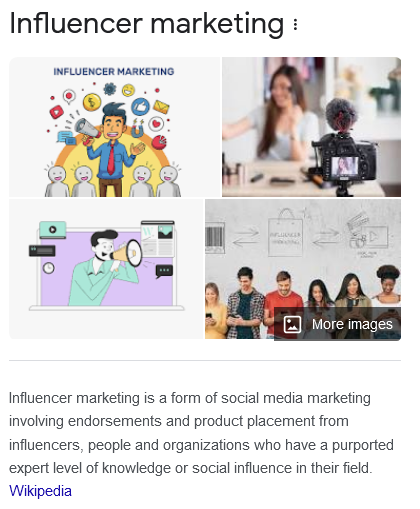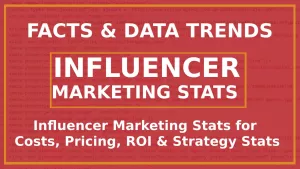Influencer Marketing Statistics
Key Stats
- Nearly 40% of marketers dedicated 10-20% of their total marketing budget to influencer marketing in 2023-2024.
- On average, businesses earned $6.50 for every $1 invested in influencer marketing.
- Influencer marketing spending increased from $3.69 billion to $4.14 billion in 2023-2024.
- Average rates for a single influencer post in 2023 were around $1,034 for TikTok, $1,200 for Instagram, and $2,500 for YouTube mega-influencers (each with over 1 million followers).
Eye Opening Influencer Marketing Statistics for 2024-2023
- Limited-time offers to motivate 18-34-year-olds in social commerce purchasing, while free shipping influences those aged 35 and older.
- Our 2022 report shows that apparel, beauty, and home products now make up 60% of social commerce purchases, marking a significant 25% rise from the previous year.
- Over one-third (37%) of survey participants have spent over $100 on social commerce transactions within the last year.
- Generally, consumers across all age groups indicate they usually need to see a product 1-2 times on social media before they decide to buy it.
- Regarding products most frequently bought on social media by U.S. users, apparel/clothing leads with 25.6%, followed by beauty/make-up products at 19.4%, and home products and electronics at 13.5%.
- Regarding the frequency of shopping on social media among U.S. users, 19% shop a few times a year, 14.5% do so monthly, and 9.3% make purchases daily.
- Instagram is the best for influencer marketing strategies, with 72% of marketers in a HubSpot survey preferring it for collaborations with influencers and creators.
- On TikTok, engagement rates vary notably by account size, peaking at 15.04% for smaller accounts (1,000 to 5,000 followers) and lowering to 10.53% for those with over 1 million followers.
- Most (80%) influencer marketers in HubSpot’s 2024 Social Media Marketing Report focus on working with smaller creators with less than 100,000 followers, while a smaller portion (16%) collaborate with celebrity influencers with over 1 million followers.
- A notable study revealed a direct relationship between increased spending on influencer marketing and higher engagement rates. Specifically, a mere 1% hike in spending on influencer marketing is associated with a nearly 0.5% rise in engagement. Following the study’s findings, a strategic reallocation of spending could lead to an engagement rate boost of up to 16.6%.
- The influencer marketing sector continues to grow and is projected to reach $21.2 billion globally in 2023. This marks a substantial rise from its $1.7 billion valuation in 2016 and a continuation from its $16.4 billion worth in 2022.
- Instagram is recognized as the leading platform for influencer marketing worldwide, with 89% of marketers identifying it as their top choice. YouTube follows at 70%, and Facebook at 45%, while TikTok, though not included in this survey, is also known to be a major player in this arena.
- The market for global influencer marketing platforms, offering services like influencer discovery, brand collaborations, and campaign management, is expected to expand to $22.2 billion by 2025, up from $15.2 billion in 2023.
- Worldwide, influencer marketing advertising spending is forecasted to reach $30.81 billion in 2023, with a projected increase to $47.80 billion by 2027.
- On average, influencer marketing advertising spending amounts to approximately $5.78 per internet user, a figure that is anticipated to grow in the coming years.
- China leads globally in influencer marketing advertising spending, with a total expenditure of $16.76 billion.
Influencer Marketing Costs Statistics and Facts
- Nano-influencers, with up to 5,000 followers and high engagement rates, charge modest fees for sponsored posts. Their rates vary by platform: $10-$100 on Instagram, $2-$200 on YouTube, $5-$25 on TikTok, $2-$20 on Twitter (labeled as ‘X’), and $25-$250 on Facebook.
- Micro-influencers, who charge more than nano-influencers, typically ask for $100-$500 for an Instagram post, $200-$1,000 for a YouTube video, $25-$125 for a TikTok video, $20-$100 for a Twitter post, and $250-$1,250 for a Facebook post. They offer a cost-effective way to gauge audience fit, especially with Instagram Stories or short TikTok videos.
- Power influencers, with a larger follower base command higher fees. Their rates range from $500-$5,000 for an Instagram video, $1,000-$10,000 for a YouTube video, $125-$1,250 for a TikTok video, $100-$1,000 for a Twitter post, and $1,250-$12,500 for a Facebook post.
- Macro-influencers, a tier above power influencers with 499,999 to one million followers, can charge up to $25,000 per sponsored post. Their rate card includes $5,000-$10,000 for an Instagram video, $10,000-$20,000 for a YouTube video, $1,250-$2,500 for a TikTok video, $1,000-$2,000 for a Twitter post, and $12,500-$25,000 for a Facebook post.
- Celebrity influencers, boasting over a million followers, have the highest rates for sponsored content. They typically earn over $10,000 for an Instagram video, over $20,000 for a YouTube video, over $2,500 for a TikTok video, and upwards of $2,000 for a Twitter post and $25,000 for a Facebook post. Top-tier celebrities like Cristiano Ronaldo and Kylie Jenner can charge significantly more, with rates exceeding $1 million per post. Collaborating with such influencers often involves working through their management teams.
Budget Stats for Influencer Marketing
- In 2022, nearly 40% of marketers allocated 10-20% of their marketing budgets to influencer marketing.
- For each dollar spent on influencer marketing channels, businesses typically see an average return of $6.50 in revenue.
- The U.S. saw a significant rise in influencer marketing expenditure in 2022, escalating from $3.69 billion to $4.14 billion.
- In 2021, the average cost for a single post by a TikTok mega-influencer (with over 1 million followers globally) was about $1,034.
- For Instagram mega-influencers (also with over 1 million followers worldwide), the average rate per post was at least $1,200 in 2021.
- YouTube mega-influencers (those with more than 1 million followers) charged a minimum of $2,500 per sponsored video in 2021.
How Can Brands Leverage influencer marketing to make more sales and reach a larger audience in 2024?
 As we look towards 2024 and beyond, brands can leverage influencer marketing to boost sales and expand their audience reach. The evolving landscape of influencer and digital marketing, underscored by compelling statistics from recent years, underscores its efficacy and potential. Notably, nearly 40% of marketers allocated 10-20% of their marketing budget to this domain in 2022, a trend that’s likely to continue. This investment makes sense, considering the impressive return on investment (ROI) reported – on average, businesses have seen $6.50 in revenue for every $1 invested in influencer marketing.
As we look towards 2024 and beyond, brands can leverage influencer marketing to boost sales and expand their audience reach. The evolving landscape of influencer and digital marketing, underscored by compelling statistics from recent years, underscores its efficacy and potential. Notably, nearly 40% of marketers allocated 10-20% of their marketing budget to this domain in 2022, a trend that’s likely to continue. This investment makes sense, considering the impressive return on investment (ROI) reported – on average, businesses have seen $6.50 in revenue for every $1 invested in influencer marketing.
The continuous growth in U.S. influencer marketing spending, which saw an increase from $3.69 billion to $4.14 billion in 2022, indicates strong confidence in this strategy. This growth is fueled by the effective reach and engagement that influencers, especially mega-influencers on platforms like TikTok, Instagram, and YouTube, command. With average rates for a single post in 2021 hovering around $1,034 for TikTok, $1,200 for Instagram, and $2,500 for YouTube mega-influencers, it’s clear that brands are willing to invest significantly in influencers with large followings due to their expansive reach and influence.
Brands can harness this potential by strategically partnering with influencers whose followers align with their target audience. This alignment enhances brand visibility and drives sales, as influencers’ recommendations often carry considerable weight with their audience. Moreover, as influencer marketing continues to evolve, brands that stay ahead of emerging influencer trends and adapt their SMM strategies accordingly will be well-positioned to capitalize on this powerful marketing channel, thereby expanding their reach and driving increased sales in 2024 and beyond.
Costs, Pricing, And Budget Concerns for 2024-2023
In the realm of influencer marketing, the spectrum of influencers, from nano-influencers to celebrities, offers an affordable price range of content creators for brands to engage with diverse audiences. Nano-influencers, who typically have up to 5,000 followers, are known for their high engagement rates and charge modest fees for sponsored content. Their rates vary across platforms, from as low as $2 for a YouTube video to up to $250 for a Facebook post, making them an accessible option for brands with smaller budgets.
Micro-influencers represent the next tier, with slightly higher charges reflecting their larger follower bases. They offer a cost-effective solution for brands to test audience engagement, especially through Instagram Stories and TikTok videos. Their charges range from $100 to $500 for an Instagram post to $250 to $1,250 for a Facebook post.
With even more significant followings, power influencers command higher fees, ranging from $500 to $5,000 for an Instagram video and up to $12,500 for a Facebook post. This group offers brands access to a wider audience pool and potentially higher-impact campaigns.
Above them are macro-influencers with followers ranging between 500,000 to one million. They can charge up to $25,000 per sponsored post, with their influence spanning across various social media platforms.
At the pinnacle are celebrity influencers with over a million followers. These high-profile individuals, like Cristiano Ronaldo and Kylie Jenner, have the highest rates, often exceeding $1 million per post. Collaborations with celebrities usually involve negotiations with their management teams and offer brands the broadest reach and visibility.
Overall, this tiered structure of influencer marketing provides brands with various options to align their marketing strategies with their budget and target audience, from grassroots campaigns with nano-influencers to high-profile campaigns with celebrity influencers.
Sources
- https://theinfluencermarketingfactory.com/social-commerce-report/
- https://influencermarketinghub.com/influencer-marketing-statistics/
- https://blog.hubspot.com/marketing/influencer-platforms
- https://sproutsocial.com/insights/influencer-marketing-statistics/
- https://www.shopify.com/blog/influencer-marketing-statistics
- https://blog.hubspot.com/marketing/influencer-marketing-stats
- https://thesocialshepherd.com/blog/influencer-marketing-statistics
- https://blog.hubspot.com/marketing/influencer-marketing-stats#influencer-marketing-budgets
- https://www.statista.com/statistics/1092819/global-influencer-market-size/
- https://grin.co/blog/influencer-marketing-statistics/
- https://startupbonsai.com/influencer-marketing-statistics/
- https://www.socialmediatoday.com/press-release/20231113-navigating-the-social-commerce-boom-insights-from-influencer-marketing-fac-1/

Craig McConnel is an experienced expert SEO consultant that is the lead SEO director at KeyStar Agency. Ranked the #1 link-building expert for over ten years, he loves making stubborn websites rank high on Google. When not writing people-focused blog content on his blog, he enjoys working out and producing music at his home studio in Ocotillo, Arizona. His expertise spans many industries, including technology, Cryptocurrency, web hosting, website design, digital marketing, car racing, fitness, finance, wellness, religion, online advertising, and of course, Search Engine Optimization.





